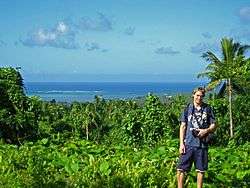Pulemelei Mound

The Pulemelei mound (also known as Tia Seu Ancient Mound) is the largest and most ancient structure in Polynesia. It is situated in Letolo Plantation in the Palauli district, at the east end of Savai'i island in Samoa.[1]
The stone mound is a pyramid constructed of natural basalt stones and at its base measures 65 by 60 metres (213 ft × 197 ft) and has a height of about 12 metres (39 ft) on the south edge and 7 metres (23 ft) on the north edge, and appears to have been oriented to the cardinal directions.[2] Excavations have revealed that it was probably constructed sometime between 1100–1400 AD and was no longer used by 1700–1800 AD. The mound was constructed with a base platform made of volcanic stones, and appears to be built on vertically placed foundations stones.[3] On top of the base stone there are three platforms on top of each other, with vertical or slightly sloping side walls. The top platform surface was level and paved with rounded stream stones, and more than 40 stone cairns were found of recent origin distributed on the top. Local informants provided that the stone piles were built when the mound was cleared of vegetation.[3]
Archaeological investigations
1977–1978
Archaeological surveys by Gregory Jackmond in 1977–1978 recorded 3000 features including stone platforms, stone fences, pathways and earth ovens.[4]
2002
Recent archeological work at the Pulemelei Mound was conducted between September 13 and October 11, 2002, by landowners of the Nelson Plantation Inc, the Kon-Tiki Museum, the Australian National University, and the National University of Samoa. Archeologists in the field were Dr. Geoffrey Clark of the Australian National University and Drs. Wallin of Kon-Tiki Museum plus twenty men from the nearby Vailoa village. The purpose of the preliminary work was to expose the mound so that a new map could be created to allow detailed description of the mound and expose the degree of structural degeneration it may have. An important find for the archaeologists included two ceramic sherds on the west side of the mound, because they are the first sherds to be found on Savai'i apart from recent discovery of pottery at Siutu Village. The sherds may also indicate that the area surrounding the mound was being used before 600 AD. In 2002, the researchers determined that further investigation and dating needs to be conducted before more secure conclusions surrounding building time periods, however researchers state that the "preliminary work shows that large structures like Pulemelei are complex constructions that may have been built over long intervals [and] are likely to have multiple functions"[3]
2007
After examining the radiocarbon data found from charcoal in several sites in Samoa including the Pulemelei Mound, the archeologists Dr. Clark, and Drs. Wallin have found that the earth ovens ( previously recorded by Jackmond), were used for cooking the root of the ti plant (Cordyline fruticosa) and cooked at high temperature becomes edible. Researchers believe the plant could have been used in ritual ceremonies. During the second half of the Samoan "Dark Age" (700–1000 AD) there is stronger evidence for human activity in the Pulemelei area. Through more radiocarbon dating the researchers also determined that "the addition of the top platform is likely to be contemporary with the construction of the Umu ti and the pavement/house on the south side of the Pulemelei mound. During this period 1450-1700AD the sunken entrance ways were also likely to have been built/rebuilt".[5]
See also
References
- ↑ "Samoa Observer Latest breaking news articles, photos, video, blogs, reviews, analysis, opinion and reader comment from Samoa and around the World Latest samoan news articles, photos, video, world, sport, technology, opinion, editorial, manu samoa". Samoaobserver.ws. Retrieved 2016-05-04.
- ↑ "Pulemelei Mound". World Monuments Fund. WMF. Retrieved August 2, 2014.
- 1 2 3 Wallin, Helene Martinsson; Clark, Geoffrey; Wallin, Paul (October 2003). "Archaeological Investigations at the Pulemelei Mound". Rapa Nui Journal. 17 (2): 81–84.
- ↑ "Apps – Access My Library – Gale". Access My Library. Retrieved 2016-05-04.
- ↑ Wallin, Paul; Wallin, Helene Martinsson; Clark, Geoffrey (2007). "A Radiocarbon Sequence for Samoan Prehistory and the Pulemelei Mound". Archaeology in Oceania. 42: 71–82.
External links
Coordinates: 13°44′6″S 172°19′28″W / 13.73500°S 172.32444°W